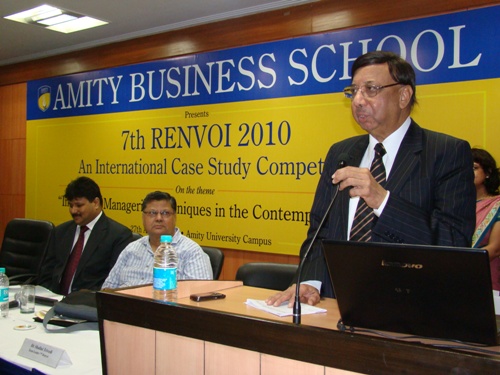27 Aug 2010|Noida | Amity University Campus, Sector-125 Noida
Amity Business School organises “7th Renvoi - International Case Study Competition” on the theme “Innovative Management Techniques in the Contemporary Ethos”

Amity Business School organized “7th Renvoi - International Case Study Competition” on the theme “Innovative Management Techniques in the Contemporary Ethos” at Amity Campus, Sector -125, Noida
Every year “Renvoi” is organized to promote intellectual capital in all facets of management and related social sciences. Cases are invited from the functional areas of management studies such as Marketing, Finance, Operations, Supply Chain, Human Resources, IT and other related areas.
Mr. B.S. Lalli-CEO, Prasar Bharti, Prof. (Dr.) Arvind Sinha, HSS Department, Indian Institute of Technology, Kanpur, Dr. Sanjay Sethi, Senior Director Engineering, Toshiba America Electronic Components, Inc, and Dr. Sanjay Srivastav, Head & ADG, Amity Business School inaugurated the Competition.
Welcoming the august gathering, Dr. Sanjay Srivastava shared that Renvoi 2010 laid emphasis on the importance of case studies for providing practical experience to the management students with special reference to qualitative case studies. Dr. Srivastava also addressed the requirement of moving from confidentiality to transparency in order to add value to the existing body of knowledge and express concerns regarding the quality of case studies going down as the students do “Copy Paste” jobs through Internet, thereby compromising on the ingenuity.
Speaking during the occasion, Dr. Ashok K Chauhan- Founder President, Amity Group said that management education is incomplete without case studies and real- life experience sharing. He motivated the students to learn the most from “Renvoi” as eminent speakers from corporate and academia will share their experiences and solve the queries of students, which has no other substitute.
While addressing the students during the inauguration of “Renvoi”, Mr. B.S. Lalli -CEO, Prasar Bharti urged Amity students to bring about change in their strategies and adapt to that change. Referring to the importance of case studies in a student’s life, he said that case study is a sample of a student’s knowledge and his analytical skils and how to extrapolate that knowledge to a bigger canvass through the application of intelligence which would decide the quality of the case study submitted by the student. He advised the budding managers to use technology to the fullest, which can provide students a better insight to understand the things. He laid stress on the challenges of the technology and advised students to master the technology rather than becoming its slave.
Dr. Sanjay Sethi made an interesting presentation, on "Managing strategic Innovation - Oxymoron or Paradigm shift" He, very vividly, introduced the concepts of Paradigm Shift, Strategic Innovation as a process and its obstacles, organizational imperatives and alternatives. He presented the illustrations on "Disruptive versus Sustaining Innovations", "Characteristics of Strategic Innovations", "Obstacles to Strategic Innovations (Why Fix What Isn''''''''''''''''t Broken?)", "Process of Successful Strategic Innovation( Forget key assumptions, Borrowing assets from established organizations and Learning to succeed in an emerging market)"and " Fostering Strategic Innovations."
While dwelling on the concept of case studies, Dr. Arvind Sinha stated that "a case is factual description of events that actually happened at some point in the past." He shared that it is basically the distinction between the fact and the description that makes the process of case studies interesting. He concluded stating that case studies must be matched to academic objectives in an instituition like Amity and urged the younghorns to acquire skils in analysis of business problems, synthesis of action plan, development of concepts, useful attitude and mature judgment wisdom.
The inauguration was followed by Case Study Presentations by speakers from Corporate and Academia, which were adjudged by eminent jury members including Mr. Vikram Karai, Sr. VP-HR, Steria India, Mr. Rajiv Sehdev, VP-HR, Moser Baer Ltd, Mr. Manoj Srivastava- Managing Director, Lintas Group, Ms. Seema Gangwar- Sr. Consultant, IBM, Mr. Rohit Bakshi- DGM(Marketing), Bharti Wall Mart and many more.
Prof. Anu Singh Lather- Dean, University School of Management Studies, Guru Gobind Singh Indraprastha University, Delhi and Ms. Sona Vikas- Research Scholar, University School of Management Studies, Guru Gobind Singh Indraprastha University, Delhi presented a case study on “LOW COST AND HIGH QUALITY: INDIGO’S SUCCESS MANTRA”. The country’s largest low-fare carrier IndiGo, run by InterGlobe Aviation Pvt. Ltd, which in turn is a part of Interglobe Enterprises, made a net profit of at least Rs. 60 crore for the quarter ended 30 June, 2009 even as the full-service carriers ran into losses due to a decline in the business class traffic and excess capacity in the market. This case study highlighted the success story scripted by IndiGo and Rahul Bhatia, the man behind its phenomenal achievement. The case concluded that if IndiGo continues to deliver what it promises, interacts with its customers consistently and in a responsible fashion over time and continues to innovate, people will continue to vote for it with their wallets, their respect and their affection.
Mr. Faraz Ahmed- Energy Data Analyst, Bureau of Energy Efficiency, Ministry of Power, Govt. of India presented a case study “Water consumption pattern in high rising buildings and evolving water management and conservation options”. The case study attempted to review the water use in a high rising building, water usage pattern, water conservation and exploring the potential of water management. The flow rates of the conduits in the distribution system were determined by an ultrasonic flow meter and by filling method. The main objectives were to quantify water usage, provide a profile of the distribution system and to identify areas where water consumption can be reduced, thereby facilitating easier and effective management of water resources and improved reliability. This real life case highlights the actual water demand, wastage points, estimation of the saving potential and the ways to achieve savings in a high rise building.